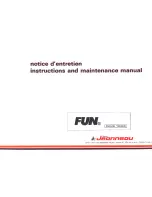
Sea-Jet Evolution
2
Technical data
Length
approx. 685 mm
Width
approx. 240 mm
Height
approx. 370 mm
Displacement/weight
approx. 2100 g
For additional items necessary to complete the model, please see
separate accessory sheet.
For tools and other useful items, please see the robbe main catalo-
gue.
Assembly sequence and instructions.
The section numbering represents general assembly sequence.
Please make yourself familiar with the instruction notes, parts list
and illustrations before and during each assembly stage.
A separate sheet illustrates the profiled plastic parts and an electri-
cal schematic diagram.
Vacuum formed (vac form) parts
After trimming the edges of the vac form parts, smooth all edges
with sandpaper.
Holes are to be drilled at the marked locations on these parts.
Profiled parts
Only remove the parts from the sheet that you will need for a parti-
cular assembly stage.
Please identify the parts and number them accordingly. This will
ease assembly later on.
Please ease the corners of the parts with a sharp modelling knife
before removing from the sheet. Please dry fit all the parts together
before gluing, they should all fit easily together, if not please use a
knife, triangular file and sanding block to achieve a perfect fit.
Adhesives and bonding
Before assembling, roughen all areas to be adhered with sandpa-
per.
Only use the adhesives recommended in these instructions.
Please read and take note of the instructions given by the adhesi-
ve manufacturer.
To bond the deck to the hull, a special adhesive is included in the
kit. ONLY USE THIS GLUE FOR THIS OPERATION.
Warm the adhesive before use in warm water. This will soften it and
make it easier to spread and form a stronger and neater joint.
Please note: this adhesive needs 24 hours to fully cure.
Before bonding parts, make a dry run to check the fit of all parts to
be bonded. When using Stabilit-Express, don’t be tempted to make
a large glue fillet, you will get a better joint if you evenly spread it
out thin and evenly before joining the parts.
All hull joints where water ingress is likely (rudder bearing,
Propshaft) should be sealed with a fillet of Stabilit-Express on the
inside where they exit the hull.
After bonding, clamp all parts in position with bulldog clamps or
clothes pegs.
Only use small quantities of instant glue (cyanoacrylate) applied on
the end of a needle or length of wire.
To avoid contamination of glue joints during assembly, the model
will be dry assembled without grease first. Greasing and lubrication
will be made before test running.
Insulate all the solder joints with a small length of heat shrink tubing
to prevent short circuits.
Left and Right orientation is seen in the direction of travel.
All dimensions, weights are in the metric system.
Radio control system
You will need a 2-channel radio system with one rudder servo and
an electronic speed controller (ESC) with Battery Eliminator Circuit
(BEC).
It is best to have the radio available before you start assembly, so
you can orient your radio installation to suit the model. If you are
using a different radio to that recommended, please ensure that
you make the necessary adjustments to sizes and layout during the
assembly.
Please follow the radio manufacturers guidance for installation of
the receiver aerial.
Set the rudder steering servo to its central neutral position (trans-
mitter stick and trim lever in the middle). You may need to remove
or change the servo arm or disc.
Before switching on the model, always ensure throttle stick is in
“motor off” position. You can then connect the drive pack to power
up the model.
When switching off, always remove drive battery pack before tur-
ning transmitter off.
Painting
The painting of pre finished hull and deck is not necessary.
Key to material abbreviations used in parts list/instructions
NI
=
not included
Br
=
brass
Pl
=
plastic
PM
=
plastic moulding
Vac
=
vac formed part
PP
=
profiled plastic part
D
=
diameter
Ali
=
aluminium
Boat stand
The boat stand is included as a vac form part; you can stiffen its
structure by bonding a plate of 4 mm plywood (not included) to the
bottom of the stand.
Stage 1
Part No. Description, size in mm
number required
1.1
Motor former, 3 PP
1
1.2
Doubler front, 3 PP
1
1.3
Doubler rear, 3 PP
1
1.4
Motor mount. 3 PP
2
• Bond the doublers, 1.2 and 1.3 to the motor former, 1.1. Pay
attention that the lower edges are all flush with each other. To
help alignment of the parts, use a piece of the waste pushed into
the slot “S”, clamp in position and remove before the adhesive
cures.
• Allow the joint to harden thoroughly before proceeding
• Slide the motor mount, 1.4 into the former assembly,
DO NOT
GLUE in place, as this part must remain removable.
Assembly and operating instructions
©
robbe Modellsport
No.
1266
Modellbau Lindinger GmbH Alte-Post-Str. 14 A-4591 Molln e-Mail: [email protected] www.lindinger.at



































